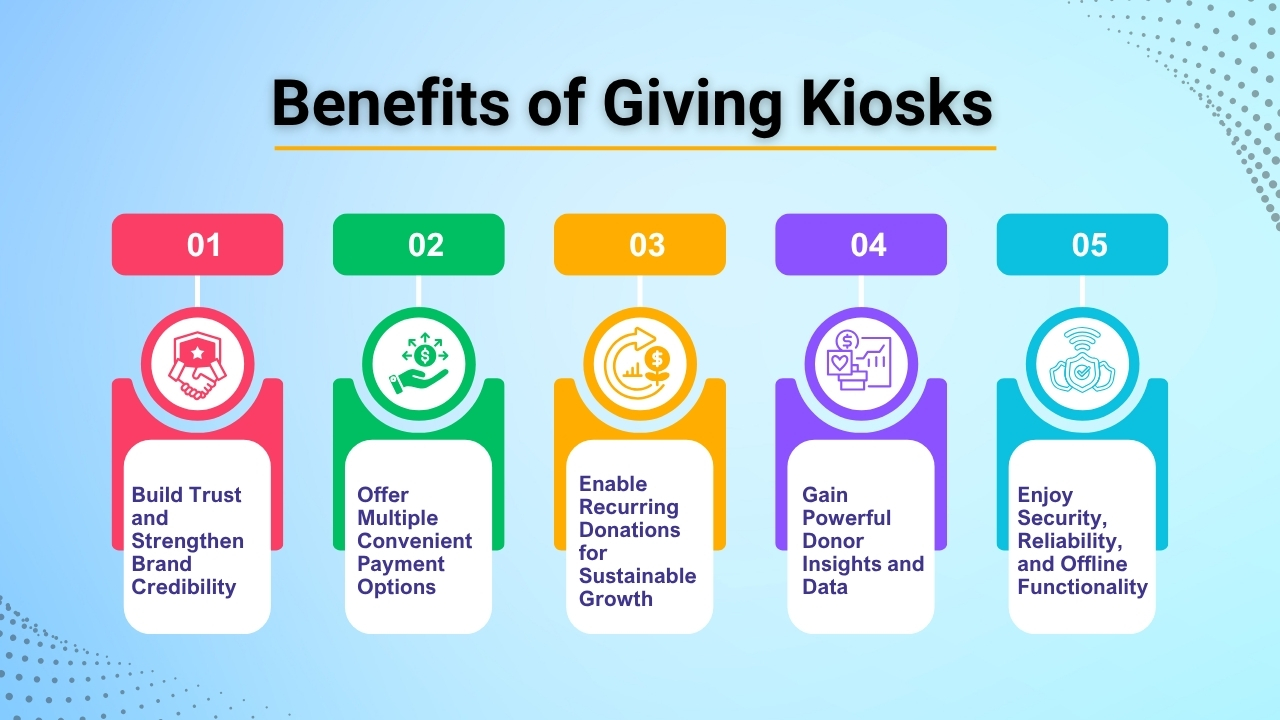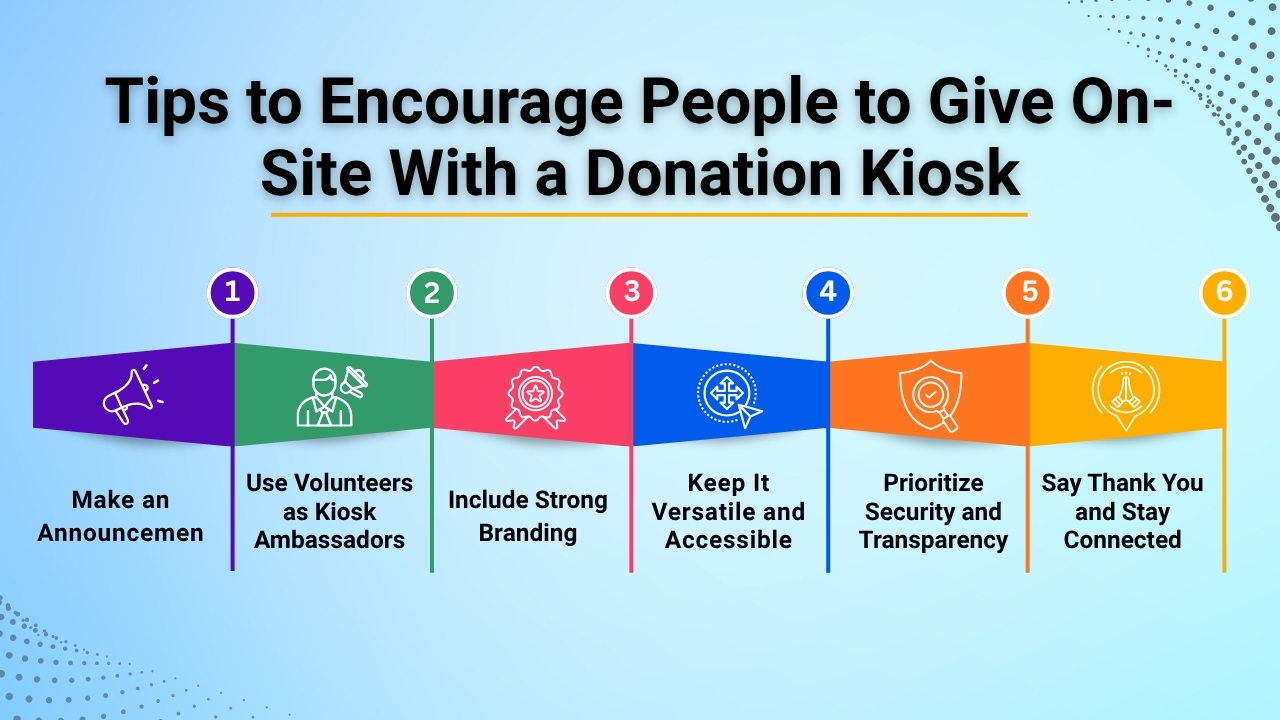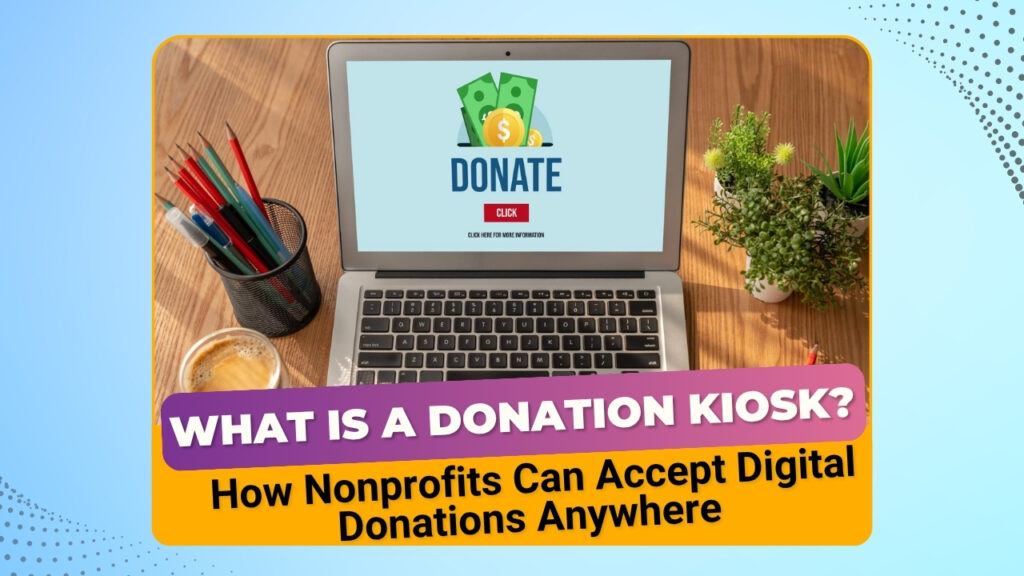In today’s fast-paced, cashless world, nonprofits require donation methods that are quick, convenient, and adaptable to where their supporters are. This is where donation kiosks come into picture that provide modern, digital giving stations that allow donors to contribute instantly using cards, smartphones, or contactless payments.
So whether placed in a church lobby, museum entrance, event venue, or community center, kiosks make it easier for people to give on the spot even if they don’t have cash in hand.
A donation kiosk is a self-service touchscreen terminal or tablet-based setup designed to collect digital contributions securely.
It connects to payment gateways and donor management systems that enables nonprofits to accept one-time or recurring gifts via debit or credit cards, mobile wallets, or NFC options like Apple Pay and Google Pay.
Providing intuitive interfaces, branded visuals, and preset donation amounts, such kiosks transform the act of donation into a smooth, interactive experience.
For organizations, the benefits of Donation Kiosk go beyond convenience. Donation kiosks reduce manual cash handling, make reconciliation faster, and integrate directly with donor databases for automated tracking and tax receipts.
They also allow nonprofits to collect donations at off-site events, or conferences without needing any extra volunteers that lets them to expand fundraising without requiring any extra volunteers to manage transactions.
Being in an era where digital payments are widely done, donors expect flexibility and instant gratification. A kiosk fulfills this expectation by offering a familiar, user-friendly way to support causes that they care about at any time and anywhere.
So whether it’s a visitor making a quick museum contribution or a churchgoer setting up a recurring tithe, donation kiosks fill the gap between traditional giving and modern technology.
And for nonprofits who are aiming to improve engagement, streamline operations, and make giving effortless, adopting donation kiosks is no longer just an advancement rather it’s a strategic move toward a more connected, digital future of fundraising.
What is a Donation Kiosk?
A donation kiosk is a self-service, cashless station which allows supporters to contribute in seconds with a tap, dip, or swipe. Being usually built around an iPad or Android tablet along with an EMV or contactless card reader, it accepts credit or debit cards and digital wallets such as Apple Pay and Google Pay making it a perfect choice for foyers, lobbies, museum, and fundraising events where people hardly carry cash.
Kiosks create a smooth and engaging giving journey by combining convenience with personalization allowing donors to connect with your cause while completing their gift in seconds.
For faith-based organizations and event fundraisers the speed and simplicity which donation kiosks provide reduce kiosks, improve completion rates, and reduce staff or volunteer involvement.
Such solutions connect to a reader for fast, secure transactions on tablets. So if you prefer maximum portability, then Tap-to-Pay on supported Android smartphones uses the device’s built-in NFC so you can accept contactless gifts without needing extra hardware.
They also simplify administrative work by automatically recording every transaction, reducing manual entry errors, and ensuring all donations are securely tracked and easily reportable.
So select a pre-configured kiosk that comes as a bundle with table stand, card reader, cables, and instructions shipped to your door, so you can unbox, sign in, and start accepting digital donations anywhere.
Benefits of Giving Kiosks

Donation kiosks are transforming how nonprofits collect gifts at in-person events, places of worship and community gatherings. Being in today’s increasingly cashless society, such kiosks provide donors with a frictionless and secure digital giving experience while helping organizations to maximize contributions and streamline operations.
So whether you are hosting a fundraising, or running a community drive, or setting up a permanent station in your lobby, donation kiosks make generosity effortless for both donors and staff.
Below are five key benefits of using donation kiosks to improve your fundraising efforts:
1. Build Trust and Strengthen Brand Credibility:
Donation kiosks allow nonprofits to design a fully branded donation experience confidently. This customizable interface allows you to add your organization’s logo, color palette, and messaging that ensures donors instantly recognize your cause and you feel secure while giving.
If it is a professional or well-branded kiosk then it also indicates transparency and legitimacy increasing donor trust. A professional kiosk instantly indicates trust and legitimacy which motivates supporters to give confidently and reinforces their belief that their donation is secure and impactful.
2. Offer Multiple Convenient Payment Options:
With digital donation kiosks, your supporters are never limited to just one payment method. It supports credit and debit cards, smartphones, and even smartwatches accepting tap, dip, or swipe payments effortlessly.
Due to such flexibility lets donors give using their preferred method through Apple Pay, Google Pay, or contactless cards which results in faster transactions, shorter queues, and a smooth experience that encourages instant generosity.
3. Enable Recurring Donations for Sustainable Growth:
Recurring gifts are the foundation of predictable revenue. It makes it easy for donors to set up ongoing rights on the spot.
By providing up to four recurring donation intervals like weekly, monthly, quarterly, or annually, you encourage consistent contributions which strengthen the financial stability of your organization.
Such steady income allows nonprofits to plan ahead and invest in long-term programs, and continue their mission with confidence.
4. Gain Powerful Donor Insights and Data:
Donation kiosks are not just about collecting funds rather they are valuable data-gathering tools. Nonprofits can include up to three custom questions in order to understand more about donor motivations, demographics, or interests.
With permission, kiosks can also collect essential contact information like email addresses, phone numbers, and mailing addresses. Such data integrates directly into your CRM allowing you to follow up with personalized messages, thank-you emails and future campaign updates. The more you know about your supporters, the strangers your relationships and retention rates become.
5. Enjoy Security, Reliability, and Offline Functionality:
Trust and security are important in fundraising technology. While the donation kiosks that use industry-leading encryption and PCI compliance standards, ensure every donation is processed safely.
Even if there is no internet, the Offline Auto-Sync Donations feature ensures no donation is lost by automatically syncing all transactions once the device reconnects.
Why They Matter: The Case for Donation Kiosks
Here are key reasons donation kiosks are increasingly seen as essential for modern fundraising:
1. Meeting Donors Where They Are:
Donors today are more habitual to contactless payments, mobile wallets, and smooth digital experiences. Only a kiosk that matches with such expectations removes friction from the giving process.
Many visitors may not carry cash or cheque which means traditional donation boxes or manual payments may miss chances for donations. A digital kiosk ensures that you are capturing donations in a way matching with modern payment habits.
2. Extending Reach and Availability:
Donation kiosks let you turn any physical touch-point into a giving station. According to a source, donation kiosks can be placed strategically in different locations transforming every physical touchpoint into a 24/7 fundraising channel.
In events, conferences, or temporary setups like fundraisers, kiosks provide a mobile, deployable means of collecting on-site donations with very less extra staff.
3. Streamlining Operations and Data:
With automated payment handling, integrated donor consent and data capture, real-time analytics, and less dependence on cash or manual card machines, kiosks make backend operations smoother. For nonprofits, it means fewer administrative burdens and lower risk of manual error.
Real-time dashboards and reporting allow your team to track performance on the sport and make faster decisions regarding placement, messaging, or campaign design.
4. Enhancing Donor Experience:
A well-designed kiosk is intuitive, branded and aligned with your mission creating a positive experience for the donor. For many visitors, giving in the moment of inspiration is more likely when donation is smooth.
The kiosk can offer suggested donation amounts, recurring-gift setups, designations and in some donation kiosk models multilingual capabilities. Such features make giving more engaging and personal.
5. Capturing More Donations:
Because kiosks reduce friction and expand where and how donations can be collected, nonprofits often experience an increase in overall giving at in-person locations.
What Should Donation Kiosks Include for an Effective Giving Process?
A successful donation kiosk not just simply collects funds rather it creates a smooth, positive giving experience which encourages generosity and builds long-term supporter trust.
To achieve this, your kiosk should be thoughtfully designed, intuitive to use, and equipped with smart features which simplify giving with more customer engagement and data insights.
Below are five essential elements every nonprofit should include to make the most of its donation kiosk setup.
1. Mobility and Flexibility:
Nonprofits often organize a wide range of fundraising activities like community drives, church gatherings, outdoor events. To maximize your reach, your donation kiosk should be easily transferable and quick to set up at any venue.
Mobility ensures your organization can accept donations anywhere supporters feel encouraged to give whether it’s a weekend market or an annual conference.
Modern kiosks use tablets or smartphones along with card readers due to which relocation becomes effortless. Due to which you can move from indoor to outdoor events without any heavy equipment.
2. Ease of Use and Simple Design:
Your kiosk should be intuitive where supporters should instantly understand how to give without any help. Keep the donation process short and consistent across all transactions.
Ideally donations must happen within four steps which are select amount, choose payment, confirm, and receive receipt. Ensure you avoid overloading donors with lengthy forms or too many optional questions as it can lead to friction. Rather use clear instructions on the screen and visual cues like icons or progress bars to make navigation effortless.
3. Fast, Secure, and Diverse Payment Options:
Speed is one of the biggest advantages of digital giving. Donors should be able to complete a transaction in seconds through a tap, dip, or swipe. Integrate your kiosk with a reliable payment processor which supports credit or debit cards and digital wallets such as Apple Pay, Google Pay, and Samsung Pay.
It enables turning your tablet and card reader into a powerful giving station which accepts all major payment methods like Visa, Mastercard, American Express, and Discover. Donors can even donate via smartphones and smartwatches for real contactless convenience.
4. Integrated QR Codes for Deeper Engagement:
QR codes are a small but powerful implementation to your donation kiosk. It can redirect donors to encouraging videos, campaign pages, or impact stories helping them see the real-world results of their generosity.
When placed prominently on the kiosk screen, a QR code can also serve as a secondary giving channel for those who prefer donating via their own phones.
5. Smart Data Tracking and Analytics:
Behind every successful fundraising campaign is data. Your kiosk should instantly capture important donor metrics like transaction history, donation amounts, preferred payment methods. Such insights show trends and help you refine your in-person fundraising strategies.
It effortlessly syncs donation data with the Donorbox platform allowing your team to track performance in real time. You will see which events generated the most gifts, and what times donors gave most frequently, and how recurring contributions are growing.
How can I encourage donor donations anywhere?
1. Free donations online:
Use a trusted mobile-first platform where donors save a card only once and give in seconds with no long forms or failed SMS codes. There you get a branded page, kiosk-style-in person mode, and digital receipts immediately. Funds can arrive as early as the next business day with no contracts or hidden fees.
2. Increase donations:
Offer flexible payment options and reduce friction with one-tap giving, Apple or Google pay, add smart presets and highlight impact. Also make relationships with donor data stronger by tracking campaigns, interests, and responses, then send customized thank-yous and follow-ups. Nonprofits often experience an increase in donations after adopting mobile giving and recurring options.
3. Grow monthly giving:
Make “Monthly” the default, explain benefits with stable programs, predictable impact and offer friendly amounts. Also segment supporters and run targeted campaigns. Donors manage recurring gifts with such platforms in one place, while your dashboard shows real-time insights and reports. Also link the giving button across web, social, email, and your kiosk to capture gifts everywhere.
Tips to Encourage People to Give On-Site with a Donation Kiosk

Donation kiosks are a new concept for many nonprofit supporters who make donations through cash or cheque donations. But with the right strategies, you can make your kiosk an exciting and trusted part of your in-person fundraising efforts.
By combining clear communication, strong branding, and human connection, your organization can help supporters feel confident using digital giving methods. Here are six detailed tips to help you inspire more on-site giving through your donation kiosk.
1. Make an Announcement:
The first step to encourage donations through your kiosk is by letting people know that it exists. Many attendees at events or services may not even realize that there is a digital giving station nearby.
Make the most of every opportunity to make an announcement regarding a donation kiosk, during your church’s Sunday service, or a community event.
Also explain shortly about how it works and mention that donors can give easily using their cards, phone, or smartwatches also how fast, safe, and convenient it is especially for those who no longer carry cash.
And if you can’t make in-person announcements, send an email newsletter, post on social media, or add visible signage near the kiosk.
2. Use Volunteers as Kiosk Ambassadors:
Even in this era human connection still matters for digital giving. Make sure you assign one or two friendly volunteers near the kiosk during busy hours to guide donors through the process. They can help visitors by answering their question, explaining the available payment methods, or show first-time users about how to tap or swipe their cards.
This is especially valuable for older donors or those less familiar with new technology. With a volunteer’s reassurance and patience can encourage people.
Make sure that volunteers are trained well that they should know how to set up, process transactions and more. Also encourage them to smile, greet visitors, and thank each donor personally.
3. Include Strong Branding:
Your donation kiosk should be like an extension of your organization’s identity. Branding helps you to build trust and indicates legitimacy to your supporters.
Ensure that you customize the kiosk interface with your logo, brand colors, tagline, and mission statement. It helps donors to recognize that they are giving directly to your cause and not a third party machine.
Also take one step ahead by placing brochures, posters, or flyers nearby that tell the story of your organization, show impact photos, and include contact details for staff or board members.
4. Keep It Versatile and Accessible:
Convenience is everything in modern giving. The more the ways that donors can contribute, the more likely they will act generous impulsively. Make sure that your kiosk accepts different payment options like credit and debit cards, digital wallets such as Apple Pay, Google Pay, and Samsung Pay.
Make your kiosk portable so it can travel between locations which are your office, outdoor fairs, benefit dinners, or community events. Such mobility ensures that no opportunity to give is missed.
Also use your kiosk to not just collect donations but also for informing new visitors. Include links or QR codes which lead to your website, volunteer signup form, or upcoming events page. And in this way, even those who don’t donate immediately stay connected with your mission.
5. Prioritize Security and Transparency:
Security is one of the top concerns donors have when trying out new giving technologies. Ensure that your kiosk uses PCI-compliant, encrypted payment processing and is connected to a trusted provider.
Reassure donors that all transactions are secure, encrypted, and fraud-protected. You can also display short on-screen messages and provide peace of mind to your visitors.
By using a cashless kiosk you reduce risks of mishandled funds and help you maintain transparent financial records as every transaction is instantly recorded and traceable. Also feature your organization’s verified registration or tax-exempt status.
6. Say Thank You and Stay Connected:
One should never underestimate the power of being thankful. Once a donor completes a transaction, show a personalized thank-you message on the kiosk screen.
Also can include a digital receipt with a thank-you note and an invitation to join your newsletter or set up recurring giving. Such features can be included in the backend so donors can easily opt-in for future communications.
Follow up later with an email update showing how their donation made an impact with photos, stories, or videos that help donors feel appreciated and emotionally invested in your mission.
How Donation Kiosks Work: Components & Workflow
To implement a donation kiosk effectively, it’s important to understand how the system operates which includes physical components, digital workflow which connects donors, payment processors, and your organization’s backend.
Each element plays an important role to offer a smooth giving experience. Below are the six essential components and functions which define how donation kiosks work.
1. Hardware Enclosure or Stand:
Every kiosk begins with durable hardware. It includes a floor stand, countertop, or wall-mounted enclosure that houses a tablet either iPad or Android, or a touchscreen device.
Such enclosures are designed for public use like lockable, and damage-proof ensuring safety and longevity in high-traffic areas. While the display should be bright, responsive, and easy to navigate, making it simple for donors to interact quickly.
2. Card Reader or Contactless Device:
The core of every giving kiosk is the payment reader. It allows donors to donate through credit or debit cards, NFC tap payments, or mobile wallets like Apple Pay and Google Pay. While few advanced kiosks also support QR code scanning, offering an additional option for donors who prefer using their phones.
3. Software Interface:
The kiosk interface is what donors see and interact with so it must be user-friendly and branded with your organization’s logo, colors, and messaging. The interface guides donors through a simple workflow which is select donation amount, choose payment method, enter details(optional), and receive receipt. Many platforms make this process intuitive and quick.
4. Secure Payment Processing:
Every donation must be processed through a PCI-compliant payment gateway for safety. It ensures transactions are encrypted and donor data remains secure. The kiosk software automatically sends donation details to your CRM or fundraising platforms. Some systems also provide offline functionality where you can store transactions temporarily until internet connection resumes.
5. Back-End Integration & Data Syncing:
An effective kiosk not just processes payments but also sync donor data, receipts, and campaign tracking directly to your backend systems. It reduces manual work and ensures that all donations are recorded, receipted, and ready for reporting or donor follow-up.
6. Dashboard & Analytics:
A cloud-based admin dashboard offers insights into kiosk performance showing total donations, transaction volume, peak usage times, and most effective locations. And with this data your organization can measure ROI, optimize placement, and make informed decisions to maximize fundraising success.
Typical Donor User Flow
Here’s a typical step-by-step scenario of how a donor uses a kiosk:
- Donors approach the kiosk station in a church or museum entrance.
- They view the screen that presents a welcome message with your organization’s branding and campaign prompt.
- The donor then selects a donation amount or enters a custom amount.
- The donor taps or swipes cards or uses their mobile wallet to pay via the reader.
- The kiosk optionally offers the donor to add contact details like name, email, phone and asks for consent for future communications.
- The system processes the payment securely, and provides immediate digital receipt.
- The donation data automatically syncs or later syncs to your CRM or fundraising platforms and you can track donation metrics in real time.
- While back-end staff track performance regarding locations that are driving most donations and in what amounts, and whether recurring members are being captured.
Conclusion:
In today’s world where people look for cashless payments and convenience worldwide, donation kiosks became an important bridge filling the gap between generosity and technology.
They empower nonprofits to collect funds instantly, securely, and efficiently at events, places of worship, community centers, or public places. It is only by offering flexible payment options like cards, mobile wallets, and contactless taps that these kiosks make giving effortless and for everyone.
Other than convenience, donation kiosks improve branding, donor trust, and operational efficiency. It also reduces manual cash handling, automates receipts and sync donor data for real-time insights which helps organizations to save time and also increase transparency. Additionally, they capture the power of impulse giving, allowing supporters to contribute the moment they feel encouraged.
As nonprofits continue to adapt to a digital-first world, implementing donation kiosks is no longer just an upgrade rather it’s a strategic move toward modern fundraising. With the right tools and thoughtful setup, any organization can transform physical interactions into powerful opportunities for impact, inspiring generosity anytime, anywhere.

